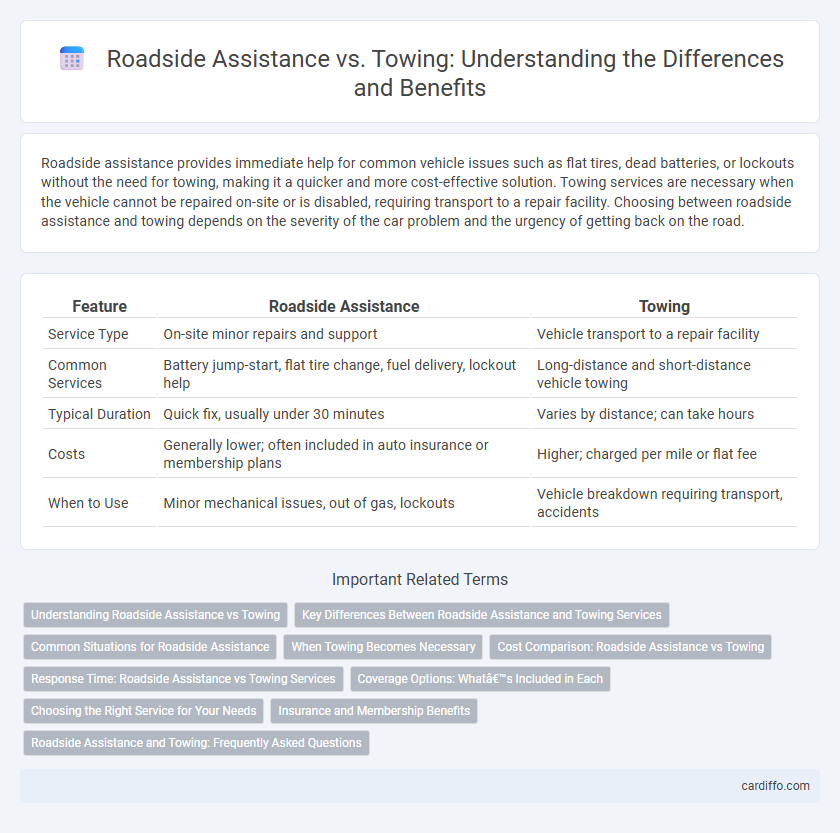Roadside assistance provides immediate help for common vehicle issues such as flat tires, dead batteries, or lockouts without the need for towing, making it a quicker and more cost-effective solution. Towing services are necessary when the vehicle cannot be repaired on-site or is disabled, requiring transport to a repair facility. Choosing between roadside assistance and towing depends on the severity of the car problem and the urgency of getting back on the road.
Table of Comparison
| Feature | Roadside Assistance | Towing |
|---|---|---|
| Service Type | On-site minor repairs and support | Vehicle transport to a repair facility |
| Common Services | Battery jump-start, flat tire change, fuel delivery, lockout help | Long-distance and short-distance vehicle towing |
| Typical Duration | Quick fix, usually under 30 minutes | Varies by distance; can take hours |
| Costs | Generally lower; often included in auto insurance or membership plans | Higher; charged per mile or flat fee |
| When to Use | Minor mechanical issues, out of gas, lockouts | Vehicle breakdown requiring transport, accidents |
Understanding Roadside Assistance vs Towing
Roadside assistance provides immediate help for common vehicle issues such as flat tires, dead batteries, or lockouts, enabling drivers to quickly resume their journey without major delays. Towing involves transporting a disabled vehicle to a repair shop or designated location when on-site repairs are impossible or unsafe. Understanding the distinction helps drivers choose the right service promptly, optimizing both time and cost during vehicle breakdowns.
Key Differences Between Roadside Assistance and Towing Services
Roadside assistance primarily provides on-the-spot services such as tire changes, battery jumps, fuel delivery, and minor mechanical repairs to get vehicles back on the road quickly. Towing services focus on transporting disabled or damaged vehicles to repair shops or safe locations when immediate repair is not possible. Key differences include the scope of service, with roadside assistance offering temporary fixes and towing handling vehicle relocation.
Common Situations for Roadside Assistance
Common situations for roadside assistance include flat tires, dead batteries, lockouts, and fuel delivery when drivers run out of gas. Roadside assistance services provide quick, on-the-spot help to get vehicles back on the road without the need for towing. This service is ideal for minor vehicle issues that don't require transportation to a repair facility.
When Towing Becomes Necessary
Roadside assistance is designed to provide immediate help for minor vehicle issues such as battery jump-starts, flat tire changes, or fuel delivery. Towing becomes necessary when a vehicle is immobilized due to severe mechanical failure, accident damage, or safety concerns that prevent safe operation. Understanding the distinction ensures timely and appropriate service, minimizing downtime and preventing further vehicle damage.
Cost Comparison: Roadside Assistance vs Towing
Roadside assistance services typically cost between $50 and $150 depending on the type of service, such as jump-starts or tire changes, making them more affordable for minor vehicle issues. Towing expenses generally range from $75 to $125 for the first few miles, with additional fees accruing per mile, which can quickly increase the total cost for longer distances. Comparing costs, roadside assistance offers a budget-friendly solution for immediate minor repairs, whereas towing becomes significantly more expensive, especially for extended distances or complex recovery situations.
Response Time: Roadside Assistance vs Towing Services
Roadside assistance typically offers quicker response times, often arriving within 30 minutes, as it involves minor repairs or services at the vehicle's location. Towing services may require longer wait times, averaging 45 minutes to an hour, due to the need for specialized equipment and transportation to repair facilities. Faster roadside assistance minimizes downtime, providing immediate solutions like battery jumps or tire changes, whereas towing addresses more severe breakdowns needing vehicle relocation.
Coverage Options: What’s Included in Each
Roadside assistance typically includes services such as jump-starts, tire changes, fuel delivery, and lockout assistance, offering basic support without needing to tow the vehicle. Towing coverage provides transportation of the disabled vehicle to a repair shop, often extending to longer distances depending on the plan. Many insurance or auto club memberships combine both options, ensuring drivers have comprehensive protection for unexpected breakdowns and more severe mechanical issues.
Choosing the Right Service for Your Needs
Roadside assistance provides immediate help for minor vehicle issues such as flat tires, dead batteries, or lockouts, offering convenience and quick resolution without the need for vehicle transport. Towing services become essential when a vehicle is inoperable or unsafe to drive, requiring transportation to a repair shop or safe location. Selecting the right service depends on the nature of the problem, distance from repair facilities, and urgency, ensuring efficient and cost-effective vehicle recovery or repair support.
Insurance and Membership Benefits
Roadside assistance provides quick, on-the-spot services such as tire changes, fuel delivery, and battery jumps, often included in insurance policies or offered through membership programs for enhanced convenience and cost savings. Towing services cover vehicle transport to repair shops or safe locations, typically included as a higher-tier benefit in insurance plans or as a premium feature in roadside assistance memberships. Choosing comprehensive coverage ensures access to both emergency repairs and towing, maximizing protection and minimizing out-of-pocket expenses during vehicle breakdowns.
Roadside Assistance and Towing: Frequently Asked Questions
Roadside assistance provides immediate services such as battery jump-starts, tire changes, and fuel delivery to get drivers back on the road quickly, while towing involves transporting a disabled vehicle to a repair shop or safe location. Common questions include when to call for roadside assistance versus towing, coverage differences in insurance plans, and cost implications for each service. Understanding these distinctions helps drivers choose the right help based on the severity of their vehicle issue and service availability.
Roadside assistance vs towing Infographic

 cardiffo.com
cardiffo.com